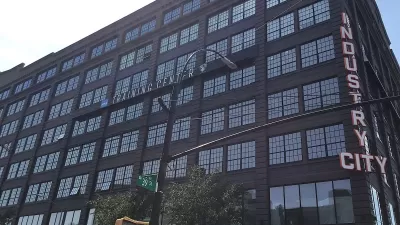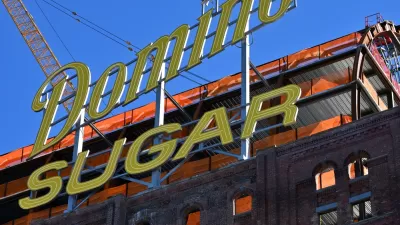Aspiring-to-be-hip cities across the county tout themselves as the "next Brooklyn." Ben Adler argues not only the Brooklyn is a lousy model for revitalization but also that hipster-led gentrification does not lead to overall prosperity.

Over the past ten years, the once-forgotten borough of Brooklyn has become the standard for all things hip, revitalized, and deliciously urban. Other cities, in turn, have aspired to become the "next Brooklyn" or have been crudely dubbed the "next Brooklyn" by observers, many of whom have a New York bias. Grist's Ben Adler unpacks these optimistic proclamations, noting that Brooklyn itself—as in the whole borough—isn't even the next Brooklyn and that threats of displacement and rising costs of living for remaining residents pose significant challenges.
In other words, gentrification's benefits are limited while its perils may be more widespread than boosters would like to think. Brooklyn is therefore as much a cautionary tale as it is an exemplar.
"The irony is that a series of neighborhoods in Manhattan were the epitome of gentrification for decades before Brooklyn was: first Greenwich Village, then the East Village and the Lower East Side (for artsy bohemians), the Upper West Side (for genteel liberal professionals), and SoHo and Tribeca (for visual artists who turned abandoned factories into lofts and studios)."
"Most of Brooklyn — New York City’s second-poorest borough after the Bronx — is untouched by gentrification. Looking at Brooklyn as a whole, you see little evidence of growing affluence. According to the U.S. Census, in 2013 only 31 percent of Brooklynites over the age of 25 had a bachelor’s degree, the median household income was only $46,000 per year, and 23 percent of residents lived in poverty."
"Yes, parts of Brooklyn such as Williamsburg and Park Slope, where I grew up, have higher incomes and lower poverty rates than they did 20 years ago. But that’s not because the poor people who lived there 20 years ago have been blessed with higher-paying jobs. It’s because they’ve been kicked out and replaced with richer people who grew up elsewhere."
"So what does it mean for the counterparts of these communities in Compton or Detroit to say their city will become the next Brooklyn? Nothing — it’s a meaningless statement. If you walk around Brownsville right now, you will see no evidence that it is a better, happier place because Williamsburg is expensive and filled with European tourists buying Brooklyn-themed t-shirts."
"Nonetheless, Compton’s Mayor Brown and the rest of the “next Brooklyn” crowd are right about one thing: a city being a desirable destination for professionals can benefit that city’s residents and society as a whole. Detroit has only 37 percent of its peak population. In depopulated Rust Belt cities, attracting any taxpaying residents is a good thing for them and for the environment. These communities need to regain density to revitalize their economies and lower their per capita carbon footprint."
FULL STORY: Why cities should stop trying to be the next Brooklyn

Alabama: Trump Terminates Settlements for Black Communities Harmed By Raw Sewage
Trump deemed the landmark civil rights agreement “illegal DEI and environmental justice policy.”

Study: Maui’s Plan to Convert Vacation Rentals to Long-Term Housing Could Cause Nearly $1 Billion Economic Loss
The plan would reduce visitor accommodation by 25% resulting in 1,900 jobs lost.

Why Should We Subsidize Public Transportation?
Many public transit agencies face financial stress due to rising costs, declining fare revenue, and declining subsidies. Transit advocates must provide a strong business case for increasing public transit funding.

Paris Bike Boom Leads to Steep Drop in Air Pollution
The French city’s air quality has improved dramatically in the past 20 years, coinciding with a growth in cycling.

Why Housing Costs More to Build in California Than in Texas
Hard costs like labor and materials combined with ‘soft’ costs such as permitting make building in the San Francisco Bay Area almost three times as costly as in Texas cities.

San Diego County Sees a Rise in Urban Coyotes
San Diego County experiences a rise in urban coyotes, as sightings become prevalent throughout its urban neighbourhoods and surrounding areas.
Urban Design for Planners 1: Software Tools
This six-course series explores essential urban design concepts using open source software and equips planners with the tools they need to participate fully in the urban design process.
Planning for Universal Design
Learn the tools for implementing Universal Design in planning regulations.
Smith Gee Studio
Alamo Area Metropolitan Planning Organization
City of Santa Clarita
Institute for Housing and Urban Development Studies (IHS)
City of Grandview
Harvard GSD Executive Education
Toledo-Lucas County Plan Commissions
Salt Lake City
NYU Wagner Graduate School of Public Service




























